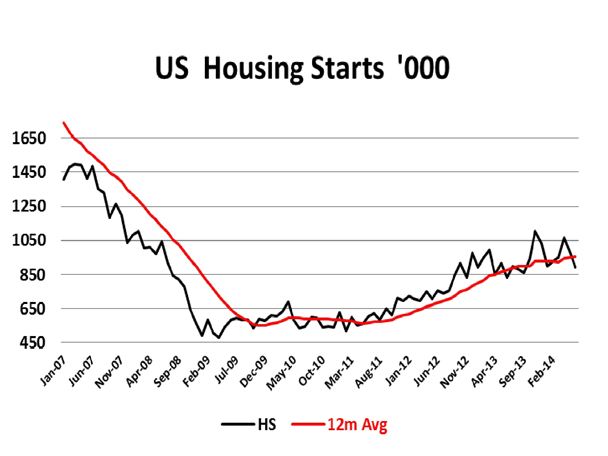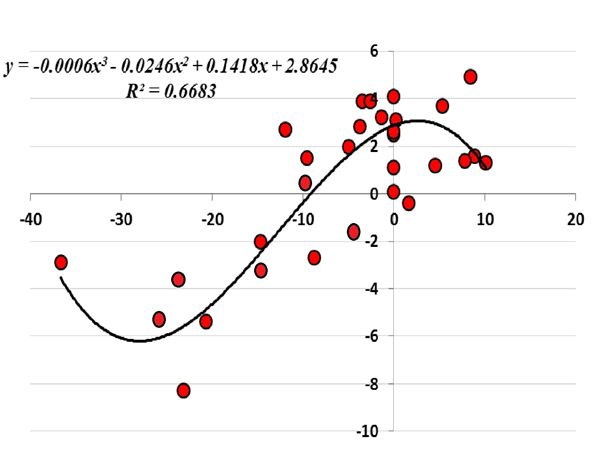Housing’s contribution to US GDP is 18 percent and it can be measured in two ways. First in terms of private residential investment, which on average is about 5 percent of GDP. Second is in the consumption spending on housing services, which averages around 13 per cent of GDP. This percentage contribution can vary over the course of the business cycle.
So what should investors in US assets make of the news from July 17 that June housing starts declined by 9.3 percent to an annual rate of 893,000 (SA basis)? That took the June number below the 12 month rolling average of 953,080 and is listed as the weakest reading since September of last year (863,000…12 month rolling average 900,420). It was also the second consecutive monthly decline.
 Geographic variations:
Geographic variations:
Housing starts in the South declined 29.6 percent; the largest fall on record and was in contrast with other regions in the US that all booked gains. Construction in the Midwest rose by 28 percent and in the North-east, the gain measured 14 percent.
In the South, home builders reported that the region's abnormally wet winter and spring have restricted the land bank of plots available for construction to begin.
The cumulative effect was that during June several builders simply could not commence work on sufficient homes to fulfill demand. There was also a consensus among Southern states' builders that staff redundancies within the municipal authorities have impacted the efficiency of gaining permits.
In Georgia “FrontDoor Communities” said that the time from receiving a permit to completing a home has expanded by three months. Clearly the impact on housing starts in the South is significant. Other regions have not been as badly affected; they have historically not looked to initiate construction during the winter; that is a direct contrast to the South.
Housing Starts for June 2014 - in the south it was -158,000 to 375,000 annual. For the rest of the US it was +66,000 to 518,000 annual
There will be a rebound
This slowdown simply means that the South will see a significant recovery in the late summer months after the region has experienced a dry late spring and early summer.
The National Oceanic and Atmospheric Association (NOAA) have reported that on average for the South:
July 2014:
• Temperature 82.5° (3° above avg. north, avg. south)
• Precipitation 5.5" (1" above avg.)
AUGUST 2014:
• Temperature 80.5° (0.5° above avg.)
• Precipitation 5.5" (1" above avg.)
The weaker than expected reading for housing starts in June will not have any destabilising impact on the economy or GDP growth. Certainly one should expect a solid recovery to materialise and my analysis indicates a good correlation between the following variables.
x = Housing Starts QoQ Percentage y = GDP Growth QoQ Percentage Change
Both time periods are matched, xt : yt
 Source: Raw data ~ US Census Bureau, Commerce Department Regression ~ Spotlight Ideas
The regression was only carried out to embrace a third degree polynomial and that generated an R-Squared of 0.6683. If the regression was raised to a fourth polynomial R-Squared rises to 0.7432 and to a fifth, R-Squared becomes 0.7473.
Even if it is assumed that housing starts is a data point that carries only medium weight, market volatility implications, we know that GDP growth is a highly significant data point that the market is glued to.
With that in mind and given the high level of growth correlation at 0.6683 I think the reversal to housing starts in June will lead to a bounce back that will have a significant upside impact on US GDP Growth for the rest of this year so reinforcing my positive outlook for US equities.
Source: Raw data ~ US Census Bureau, Commerce Department Regression ~ Spotlight Ideas
The regression was only carried out to embrace a third degree polynomial and that generated an R-Squared of 0.6683. If the regression was raised to a fourth polynomial R-Squared rises to 0.7432 and to a fifth, R-Squared becomes 0.7473.
Even if it is assumed that housing starts is a data point that carries only medium weight, market volatility implications, we know that GDP growth is a highly significant data point that the market is glued to.
With that in mind and given the high level of growth correlation at 0.6683 I think the reversal to housing starts in June will lead to a bounce back that will have a significant upside impact on US GDP Growth for the rest of this year so reinforcing my positive outlook for US equities.
